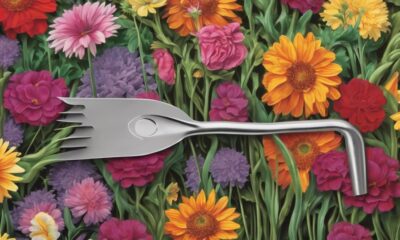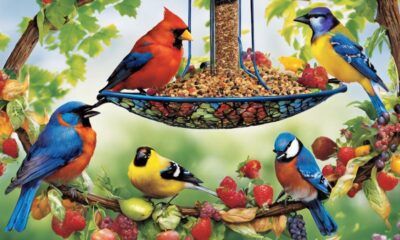Appliances
What Type of Ceiling Fan Is Best for Garage?
2025
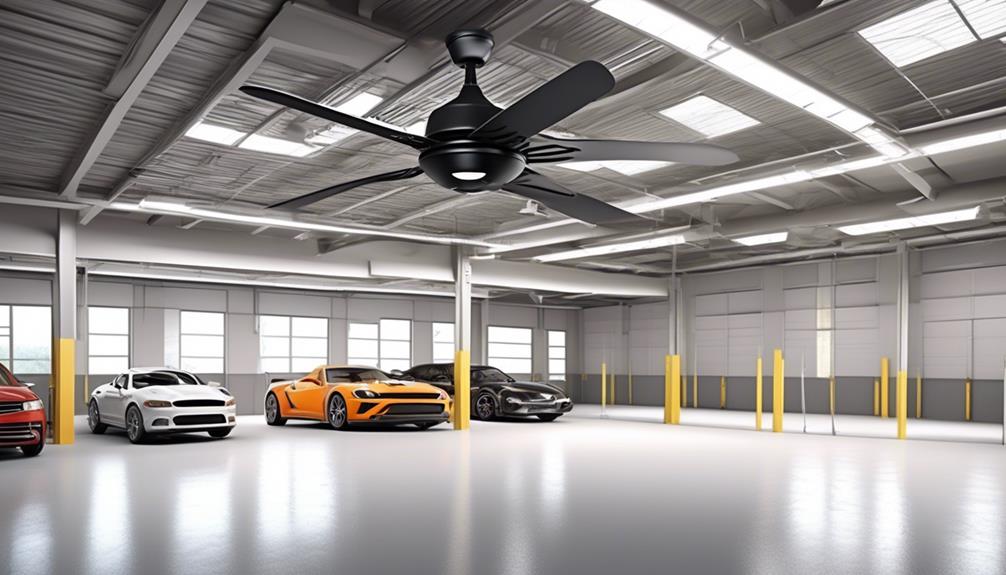
When searching for the ideal ceiling fan for your garage, we offer an extensive selection to choose from. We recognize the significance of selecting a fan that not only delivers excellent air circulation but also integrates effortlessly with the overall design of your garage.
With factors like size, blade length, and ceiling height requirements in mind, we can help you choose a fan that meets your specific needs. Additionally, we take into account details such as airflow and CFM ratings, energy efficiency, motor power, and noise level for a comfortable and quiet operation.
With our expertise, you can find a fan that not only keeps your garage cool, but also adds a touch of style to your space.
Key Takeaways
- Size and blade length, as well as ceiling height requirements, are important factors to consider when selecting a ceiling fan for the garage.
- The airflow and CFM ratings of the fan are crucial for ensuring proper air circulation in the garage.
- Energy efficiency and motor power should be considered to ensure the fan operates efficiently and effectively.
- Different types of ceiling fans, such as indoor vs. outdoor and damp vs. wet-rated, have different purposes and should be chosen accordingly.
Size and Blade Length
When selecting a ceiling fan for your garage, it's important to consider the appropriate size and blade length for optimal performance.
The size of the fan is determined by the dimensions of your garage. A larger garage requires a fan with a larger blade span to effectively circulate air throughout the space. Generally, for garages up to 144 square feet, a fan with a blade span of 36 to 44 inches is recommended. For larger garages, a blade span of 52 inches or more is suitable.
Blade length is another factor to consider when choosing a ceiling fan for your garage. Longer blades can move more air, but they require a higher ceiling to avoid any safety concerns. It's crucial to ensure that the blades are at least 7 feet above the floor to prevent any accidents. Additionally, shorter blades may be more appropriate for garages with lower ceilings as they provide sufficient airflow without any risks.
To ensure proper installation and maintenance of your garage ceiling fan, it's essential to follow these tips. Before installation, make sure that the fan is securely mounted to the ceiling to avoid any wobbling or shaking. Regularly clean and dust the blades to maintain optimal performance. Additionally, lubricate the motor and bearings annually to prevent any squeaking noises. Lastly, periodically check the fan's balance and tighten any loose screws or connections.
Ceiling Height Requirements
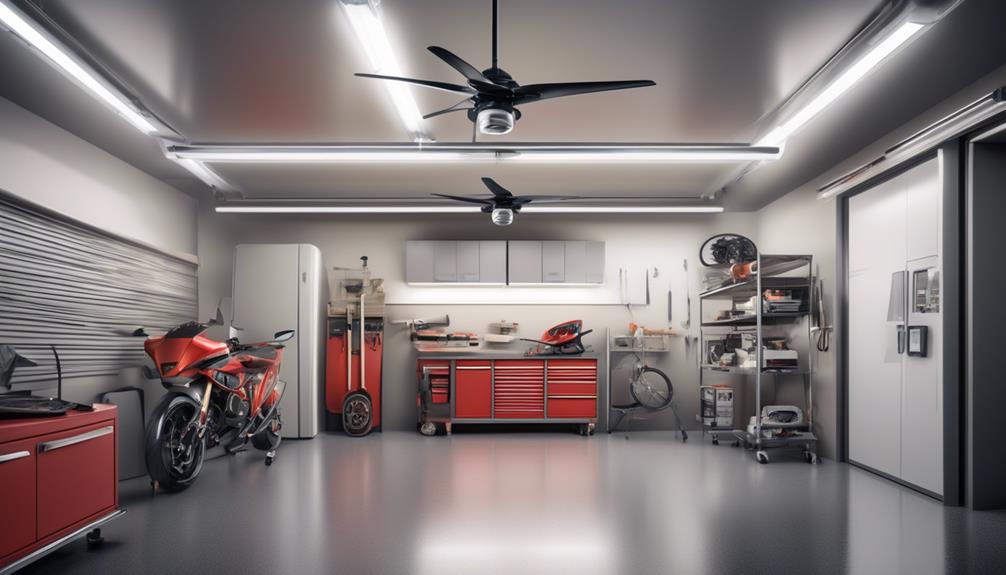
Ceiling height requirements for garage ceiling fans depend on safety regulations and the size of the fan being installed. When selecting a ceiling fan for your garage, it's crucial to consider the height of your ceiling to ensure proper installation and functionality.
The recommended minimum height for ceiling fan installation is 7 feet from the floor to the bottom of the fan blades. This allows for safe clearance and prevents potential accidents or injuries.
However, it's important to note that the height requirements may vary depending on the size of the fan. For larger fans with longer blades, a higher ceiling height may be necessary to maintain proper airflow and prevent any obstructions. It's recommended to consult the manufacturer's guidelines or consult with a professional to determine the specific requirements for your chosen ceiling fan model.
It is also crucial to consider the activities that will take place in your garage. If you plan on working on projects or using large equipment that requires additional clearance, it may be necessary to install the fan at a higher height to ensure safety and functionality.
Airflow and CFM Ratings
When it comes to ceiling fans for garages, understanding airflow and CFM ratings is crucial.
CFM, or cubic feet per minute, measures the volume of air a fan can move in a minute.
This rating is important for determining the fan's ability to circulate air effectively in the garage space.
CFM and Air Circulation
To ensure optimal air circulation and airflow in your garage, it's crucial to consider the CFM (Cubic Feet per Minute) ratings of ceiling fans. CFM ratings indicate the amount of air a fan can move per minute and are a key factor in determining its effectiveness in cooling or ventilating a space.
When choosing a ceiling fan for your garage, look for models with higher CFM ratings, as they can move more air and provide better circulation. This is especially important in larger garages or spaces with high ceilings.
Additionally, high CFM ratings contribute to energy efficiency by reducing the need for additional cooling or heating sources. By selecting a ceiling fan with appropriate CFM ratings, you can achieve better air circulation and create a comfortable environment in your garage.
Importance of Airflow
Understanding the importance of airflow in relation to CFM ratings is essential when selecting a ceiling fan for optimal air circulation in your garage. Airflow refers to the movement of air in a given space, and it plays a crucial role in ensuring proper ventilation and cooling.
When it comes to garage spaces, adequate airflow is particularly important due to factors like heat buildup, fumes from vehicles, and potential odors. A high CFM rating indicates a higher airflow capacity, which can provide several benefits for your garage.
These benefits include improved air quality, reduced humidity, and better temperature regulation. By choosing a ceiling fan with a high CFM rating, you can ensure that your garage is well-ventilated and comfortable, regardless of external conditions.
Energy Efficiency and Motor Power
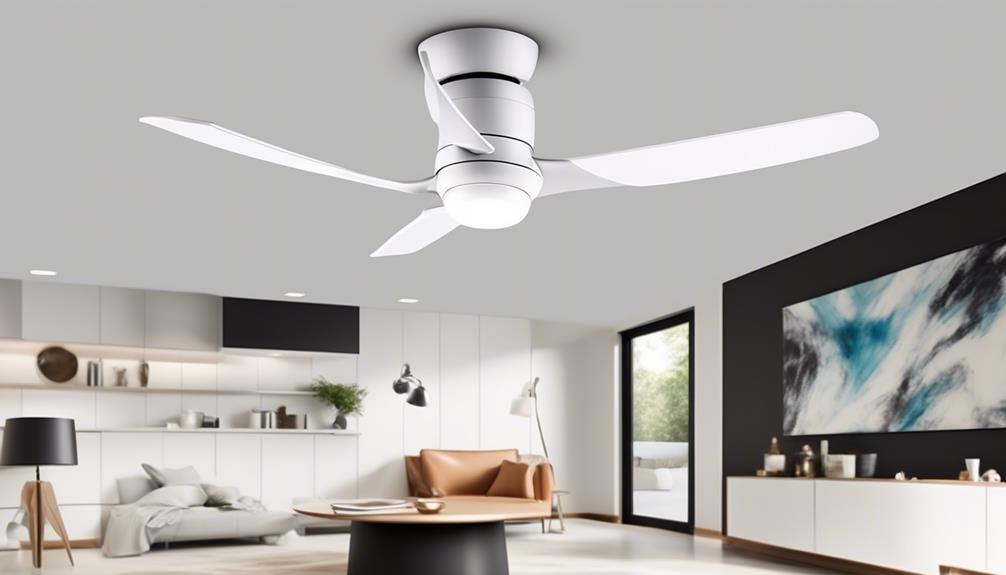
When it comes to choosing a ceiling fan for your garage, considering the energy efficiency and motor power is crucial. These factors directly influence the fan's performance and effectiveness in providing the desired airflow.
Ceiling fan design plays a significant role in energy efficiency. Look for fans that are specifically designed for energy saving technology. These fans are equipped with features such as blade shape and pitch, which optimize airflow while minimizing energy consumption. Additionally, look for fans with Energy Star ratings, as they meet stringent guidelines for energy efficiency.
The motor power of a ceiling fan determines its ability to generate sufficient airflow. A powerful motor ensures that the fan can effectively circulate air in a larger space like a garage. Look for fans with motors that are capable of high revolutions per minute (RPM) and have multiple speed settings. This will allow you to adjust the fan's speed based on your cooling needs in the garage.
Noise Level and Silent Operation

When selecting a ceiling fan for your garage, it's important to consider the noise level and ensure silent operation for a more comfortable working environment. Noise reduction is a crucial factor to consider, as garages are often used as workspaces where concentration and focus are essential. A noisy fan can be a major distraction and hinder productivity.
To achieve silent operation, it's recommended to look for ceiling fans specifically designed for quiet performance. These fans usually feature advanced motor technology and noise reduction mechanisms. One option is to choose a fan with a DC motor, as they tend to operate quieter compared to traditional AC motors.
Additionally, look for fans that incorporate noise reduction features such as sound-dampening materials, aerodynamic blade designs, and vibration isolation. These features work together to minimize noise and create a more peaceful working environment.
Furthermore, it's important to consider the fan's airflow performance. A well-designed fan can provide efficient airflow without sacrificing silent operation. Look for fans that offer a good balance between airflow capacity and noise level.
Indoor Vs. Outdoor Ceiling Fans
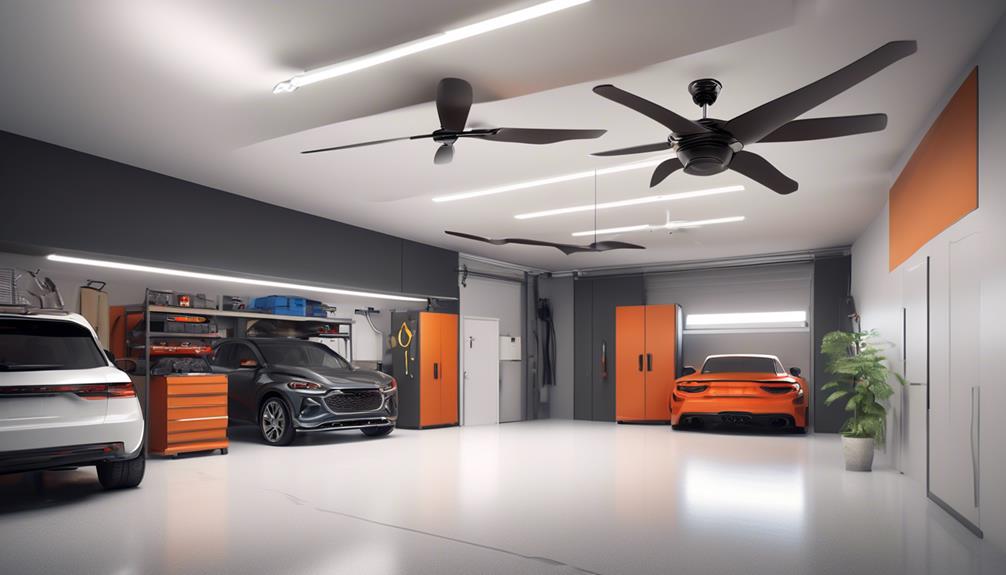
When considering whether to install an indoor or outdoor ceiling fan, there are several important factors to take into account.
First, the location of the fan is crucial as indoor fans are designed for enclosed spaces while outdoor fans are built to withstand exposure to the elements.
Durability and weather resistance are key considerations for outdoor fans, ensuring they can withstand rain, wind, and sunlight.
Additionally, airflow and cooling efficiency should be evaluated as outdoor fans may require more powerful motors to effectively circulate air in larger open spaces.
Location Considerations
To determine the most suitable ceiling fan for your garage, it is crucial to consider whether an indoor or outdoor ceiling fan would be the best fit. Ceiling fan placement and ventilation requirements are important factors that will help you make an informed decision.
| Indoor Ceiling Fans | Outdoor Ceiling Fans |
|---|---|
| Designed for use in enclosed spaces | Specifically built to withstand outdoor elements |
| Not resistant to moisture or humidity | Resistant to moisture, humidity, and extreme weather conditions |
| Ideal for cooling and improving air circulation in garages with controlled environments | Suitable for garages that are exposed to the elements, such as those with open doors or windows |
Indoor ceiling fans are not designed to withstand outdoor conditions, so they may not be suitable for garages that are exposed to moisture or extreme weather. On the other hand, outdoor ceiling fans are built to withstand these conditions and can provide a reliable cooling solution even in garages with open doors or windows. Consider the specific needs of your garage and choose the appropriate ceiling fan accordingly.
Durability and Weather Resistance
Considering the different needs for durability and weather resistance, the choice between indoor and outdoor ceiling fans becomes a crucial factor when selecting the right option for your garage. Indoor ceiling fans are designed for controlled environments and may not withstand the harsh conditions often found in garages. On the other hand, outdoor ceiling fans are specifically built to endure extreme conditions and provide resistance to moisture and humidity. Here are some key points to consider:
- Outdoor ceiling fans are constructed with materials that can withstand exposure to the elements, such as rain, snow, and high humidity.
- These fans are designed to be durable and long-lasting, even in extreme temperature variations.
- Outdoor fans are equipped with sealed motors and blades that are resistant to moisture, preventing damage and ensuring safety.
- The finishes on outdoor ceiling fans are typically coated with protective layers to resist rust and corrosion.
Airflow and Cooling Efficiency
Indoor and outdoor ceiling fans differ in their airflow and cooling efficiency, making it essential to understand these distinctions when deciding on the right option for your garage. Proper air circulation in a garage is crucial for maintaining a comfortable working environment and preventing the buildup of heat and humidity. When comparing indoor and outdoor ceiling fans, several factors come into play, including airflow capacity, energy consumption, and the benefits of proper air circulation.
| Factor | Indoor Ceiling Fans | Outdoor Ceiling Fans |
|---|---|---|
| Airflow Capacity | Moderate | High |
| Energy Consumption | Low | Moderate |
| Benefits | Enhances indoor air quality and comfort | Provides effective cooling in outdoor environments |
Indoor ceiling fans typically have a moderate airflow capacity, which is suitable for circulating air within enclosed spaces. They are designed to enhance indoor air quality and provide a comfortable environment. Additionally, indoor fans consume less energy compared to outdoor fans, making them more energy-efficient.
On the other hand, outdoor ceiling fans are designed to withstand outdoor conditions and provide effective cooling in open spaces. These fans have a high airflow capacity, allowing them to create a refreshing breeze even in hot and humid environments. While they consume more energy than indoor fans, their cooling efficiency makes them well-suited for garages that require effective air circulation.
Damp Vs. Wet-Rated Ceiling Fans
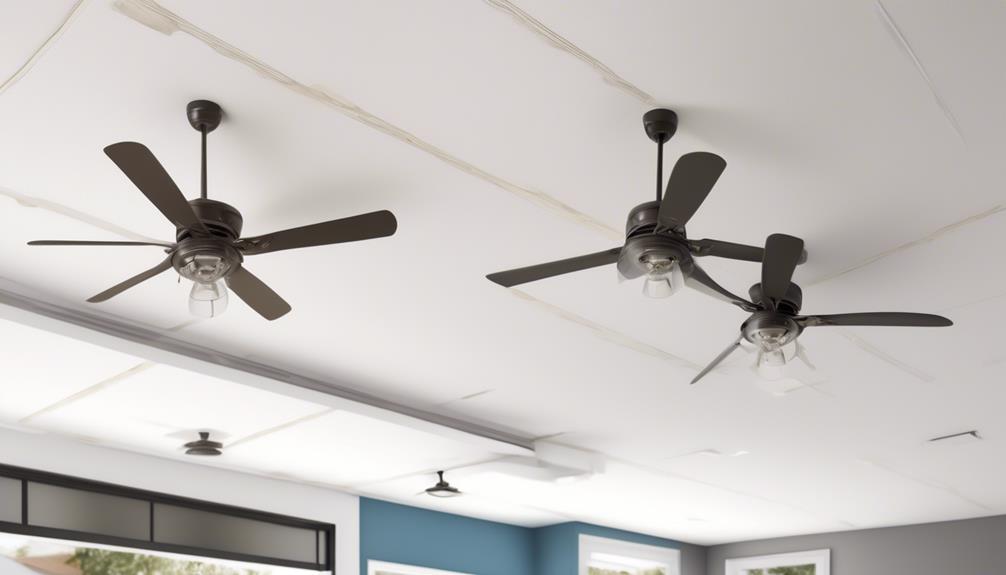
Damp and wet-rated ceiling fans are essential for maintaining proper ventilation and air circulation in garages. When it comes to choosing the right ceiling fan for your garage, it's important to understand the difference between damp-rated and wet-rated fans. Here are a few key points to consider:
- Damp-rated ceiling fans are designed to withstand moisture and humidity in indoor or covered outdoor areas. They're suitable for garages with minimal exposure to direct water contact.
- Wet-rated ceiling fans, on the other hand, are specifically engineered to withstand direct water exposure. They're ideal for garages that are prone to high levels of humidity or where there's a risk of water splashing or dripping onto the fan.
- Both damp and wet-rated ceiling fans are designed to be more durable and resistant to rust and corrosion compared to standard indoor fans.
- Before installing a ceiling fan in your garage, it's important to ensure that the electrical wiring and installation meets the necessary safety standards. Hiring a professional electrician for ceiling fan installation can help ensure a safe and efficient setup.
Downrod or Flush Mount Installation

When considering the installation of a ceiling fan in a garage, there are two main options to choose from: downrod or flush mount.
Mounting height considerations will play a significant role in determining which installation method is most suitable.
Additionally, it's important to compare the installation processes of both options to make an informed decision.
Mounting Height Considerations
We must carefully consider the mounting height when deciding between a downrod or flush mount installation for garage ceiling fans. Proper ceiling fan placement is crucial for effective garage ventilation. Here are some key points to consider:
- Ceiling Height: Measure the height of your garage ceiling to determine the appropriate mounting height. This will help ensure that the fan is positioned at the optimal level for maximum airflow and circulation.
- Clearance: Consider any obstructions or obstacles in the garage, such as shelves, cabinets, or other equipment. Make sure to choose a mounting option that provides enough clearance to avoid any potential hazards.
- Blade Length: Take into account the length of the fan blades when determining the mounting height. Longer blades may require a higher mounting height to prevent any interference with surrounding objects.
- Aesthetic Preference: Consider your personal preference and the overall look you want to achieve in your garage. A flush mount installation offers a sleek and streamlined appearance, while a downrod installation can add a touch of elegance and sophistication.
Installation Process Comparison
To compare the installation processes of a downrod or flush mount installation for garage ceiling fans, one must consider the specific requirements and steps involved in each method. The choice between these two installation methods depends on factors such as the height of the ceiling, the desired airflow, and the aesthetic preferences of the homeowner.
In a downrod installation, a rod is used to suspend the fan from the ceiling, allowing for greater clearance between the blades and the ceiling. This method is ideal for ceilings that are higher than average. On the other hand, a flush mount installation involves mounting the fan directly onto the ceiling surface, making it a suitable choice for low ceilings.
The following table provides a comparison of the installation processes for downrod and flush mount installations:
| Installation Method | Requirements | Steps |
|---|---|---|
| Downrod | High ceiling | 1. Attach the mounting bracket to the ceiling. <br> 2. Assemble the downrod and attach it to the mounting bracket. <br> 3. Install the fan motor onto the downrod. <br> 4. Attach the fan blades to the motor. <br> 5. Connect the wiring and secure the fan in place. |
| Flush Mount | Low ceiling | 1. Attach the mounting bracket to the ceiling. <br> 2. Install the fan motor onto the mounting bracket. <br> 3. Attach the fan blades to the motor. <br> 4. Connect the wiring and secure the fan in place. |
Blade Material and Durability
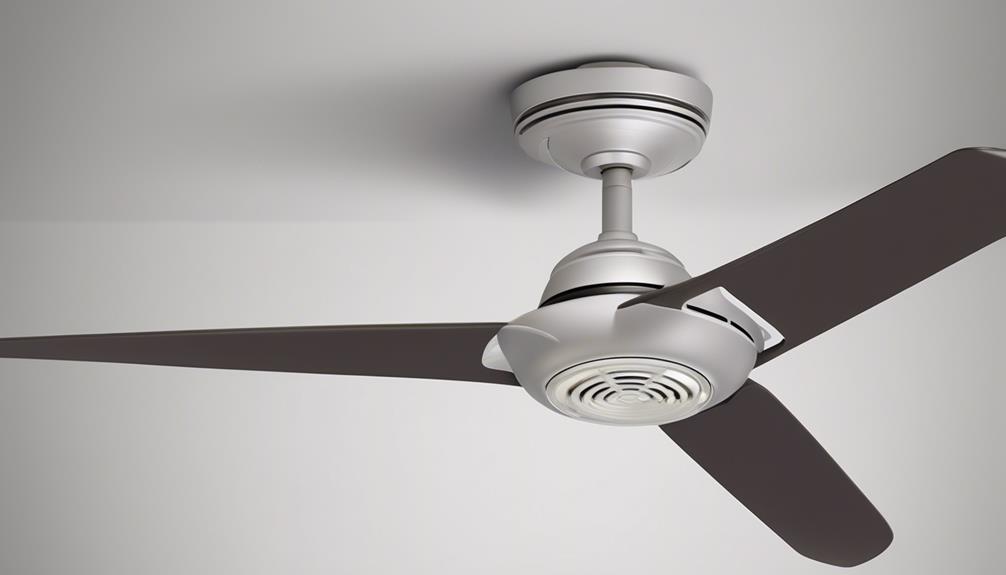
Blade material and durability are key factors to consider when selecting a ceiling fan for your garage. The type of material used for the fan blades can greatly impact its performance and longevity. Here are some important aspects to consider when comparing blade materials and durability factors:
- Metal blades: These blades are typically made of aluminum or stainless steel, offering excellent durability and resistance to rust and corrosion. They're sturdy and can withstand harsh conditions, making them suitable for garages that experience high humidity or temperature fluctuations.
- Wood blades: Wood blades provide a classic and stylish look to your garage. They're generally made from solid wood or particleboard with a wood veneer. While wood blades may not be as durable as metal blades, they can still offer good performance if properly maintained and protected from moisture.
- Composite blades: Composite blades are made from a combination of materials such as wood, plastic, and fiberglass. These blades offer a balance between durability and aesthetics. They're resistant to warping and are often treated to withstand outdoor conditions, making them a suitable choice for garages.
- Plastic blades: Plastic blades are lightweight and affordable. They're commonly made from ABS (acrylonitrile butadiene styrene) or polycarbonate materials. While they may not be as durable as other blade materials, they can still provide adequate airflow and are easy to clean.
Considering the blade material and durability factors will help you choose a ceiling fan that can withstand the demands of your garage while providing optimal performance and longevity.
Lighting Options and Fixtures
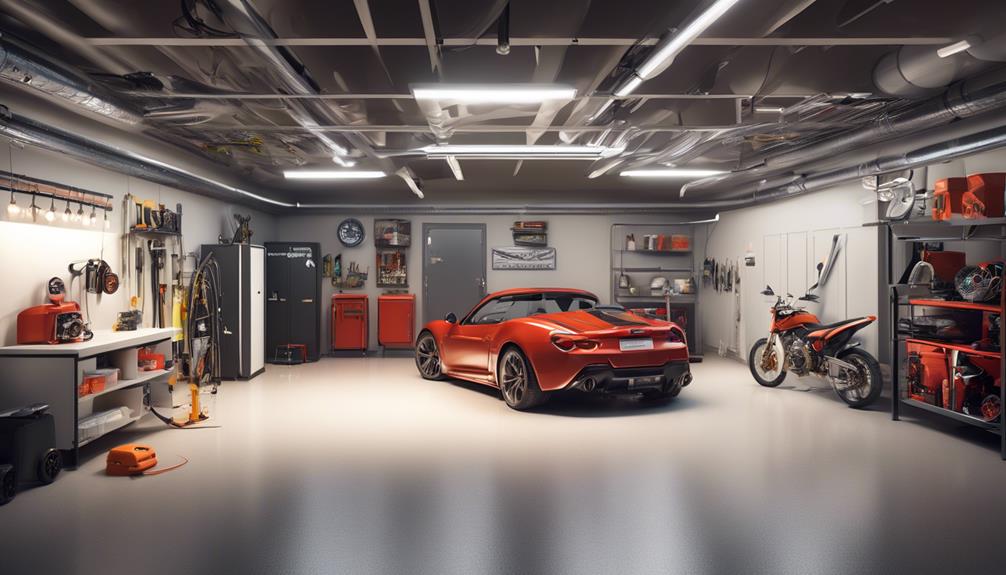
When considering ceiling fan options for a garage, it's important to also evaluate the lighting options and fixtures available. The right lighting fixtures can enhance visibility and functionality in the space, making it easier to work on projects or find tools.
Factors to consider include the brightness of the lights, the type of bulbs used, and the design of the fixtures to ensure they complement the overall aesthetic of the garage.
Ceiling Fan Lighting Options
Ceiling fan lighting options provide a versatile and efficient solution for illuminating your garage space. When considering ceiling fan design, it's important to choose one that offers customizable lighting options.
Here are some bulb types commonly used in ceiling fan lighting fixtures:
- LED bulbs: These energy-efficient bulbs provide bright illumination while consuming less electricity, making them cost-effective and environmentally friendly.
- Fluorescent bulbs: These bulbs offer a longer lifespan compared to traditional incandescent bulbs and are known for their energy efficiency.
- Halogen bulbs: Known for their crisp white light, halogen bulbs are a popular choice for ceiling fan lighting due to their brightness and color rendering capabilities.
- Incandescent bulbs: Although less energy-efficient than other options, incandescent bulbs provide a warm and inviting glow, perfect for creating a cozy atmosphere in your garage.
Choosing the Right Fixtures
After considering the various ceiling fan lighting options, it's important to choose the right fixtures that best suit your garage's lighting needs.
When it comes to ceiling fan color options, it's crucial to select a color that complements your garage's overall aesthetic. White or brushed nickel finishes are popular choices as they provide a clean and modern look.
Additionally, considering energy efficiency tips is essential for saving on electricity costs. LED light fixtures are a great option as they consume less energy and have a longer lifespan compared to traditional incandescent bulbs. Look for fixtures that are ENERGY STAR certified, as they meet strict guidelines for energy efficiency.
Remote Control and Wall Switch Compatibility

For optimal functionality and convenience, it's essential to ensure that the remote control and wall switch of your garage ceiling fan are compatible. Ceiling fan control options and installation flexibility are crucial factors to consider in order to achieve a seamless and efficient operation.
- Remote Control Compatibility: Check if the garage ceiling fan comes with a compatible remote control. It should have the necessary features to control the fan's speed, direction, and lighting from a distance.
- Wall Switch Compatibility: Ensure that the fan is compatible with a wall switch, allowing you to control the fan directly from the wall. This is especially useful if you prefer a more traditional control option or if you frequently misplace the remote control.
- Compatibility with Smart Home Systems: If you have a smart home system, make sure the garage ceiling fan is compatible with it. This will allow you to control the fan using voice commands or through a mobile app, adding an extra level of convenience.
- Wiring and Installation Flexibility: Consider the wiring requirements and installation flexibility of the fan. Some fans may require additional wiring or installation steps for remote control or wall switch compatibility. Ensure that you have the necessary wiring infrastructure in place or consult a professional electrician for assistance.
Reversible Motor for Year-Round Use
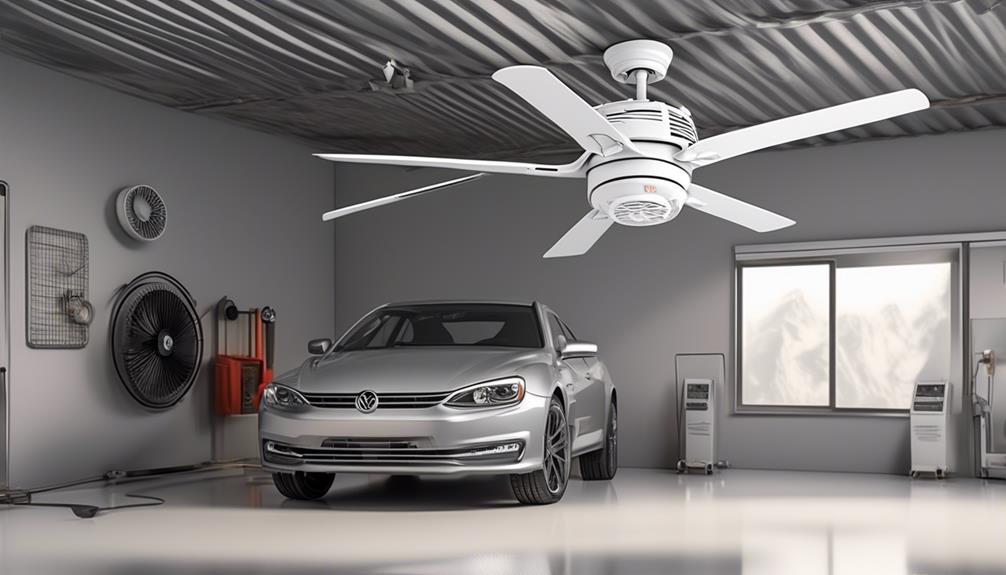
Once you have ensured remote control and wall switch compatibility for your garage ceiling fan, the next important feature to consider is a reversible motor for year-round use. A reversible motor allows the fan blades to rotate in both directions, providing benefits that make it a valuable addition to your garage.
Here are the key benefits of a reversible motor:
| Reversible Motor Benefits | Description |
|---|---|
| 1. Temperature Control | In the hot summer months, the fan blades can rotate counterclockwise to create a cooling breeze. In the colder winter months, the blades can be set to rotate clockwise, which helps to distribute warm air that rises to the ceiling. This temperature control feature ensures comfortable conditions in your garage throughout the year. |
| 2. Energy Efficiency | By using a reversible motor, you can optimize airflow and temperature control in your garage. This helps to reduce the reliance on air conditioning or heating systems, leading to energy savings and lower utility bills. |
| 3. Versatility | A ceiling fan with a reversible motor offers versatility in its functionality. Whether it's providing a cooling breeze or assisting in distributing warm air, this feature allows you to use the fan effectively in any season. |
With a reversible motor, your garage ceiling fan becomes a year-round solution for temperature control and energy efficiency. It ensures comfort, saves energy, and provides versatility with its functionality. So, when choosing a ceiling fan for your garage, make sure to prioritize a reversible motor for optimal year-round performance.
Style and Aesthetics

When considering the style and aesthetics of your garage ceiling fan, it's important to choose a design that complements the overall look and feel of your space. A well-designed ceiling fan can enhance the visual appeal of your garage while providing excellent airflow and cooling benefits.
Here are some factors to consider when selecting the style and design of your garage ceiling fan:
- Size: Ensure that the size of the fan is proportionate to the space available in your garage. A larger fan may be suitable for spacious garages, while a smaller fan would work well in compact areas.
- Blade Material: Choose a fan with blades made from durable materials such as metal or ABS plastic. These materials are resistant to wear and tear, ensuring longevity and easy maintenance.
- Color Options: Consider the color scheme of your garage when selecting a ceiling fan. Opt for a fan that matches or complements the existing color palette to create a cohesive look.
- Lighting Features: Some garage ceiling fans come with built-in lights, providing both illumination and airflow. Consider whether you need additional lighting in your garage when choosing a fan with this feature.
Price Range and Budget Considerations
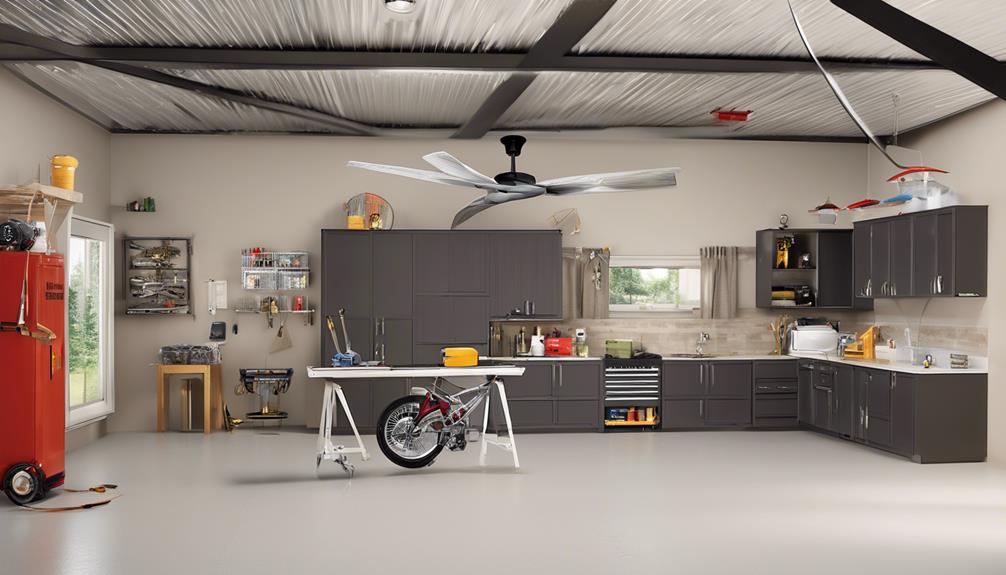
Now let's shift our focus to the important aspect of price range and budget considerations when selecting a garage ceiling fan. When it comes to purchasing a ceiling fan for your garage, it is essential to have a clear understanding of your budget constraints and the price range you are willing to work within. To help you make an informed decision, let's take a look at the table below that outlines the typical price ranges for garage ceiling fans:
| Price Range | Features | Examples |
|---|---|---|
| Low Budget | Basic functionality | Simple design, |
| limited features | ||
| Mid-range | Additional features | Remote control, |
| adjustable speed settings | ||
| High-end | Advanced technology, | Energy-efficient |
| premium design | motor, sleek aesthetics |
With this table, you can easily identify the range of prices available for garage ceiling fans and determine which category aligns with your budget. Keep in mind that while low-budget options may offer basic functionality, mid-range and high-end ceiling fans often come with additional features and advanced technology.
– How Can I Choose a Ceiling Fan for My Garage That Matches the Overall Aesthetic?
When choosing a ceiling fan for your garage that matches the overall aesthetic, consider the size, color, and style. Opt for an industrial or modern fan to complement a contemporary garage. For a more traditional space, a classic wood or metal fan will do the trick. These ceiling fan matching tips can help you achieve the perfect look.
Frequently Asked Questions
Can I Install an Outdoor Ceiling Fan in My Garage?
We can definitely install an outdoor ceiling fan in our garage. Doing so has several benefits.
First, it helps to improve air circulation, keeping the space cooler in the summer and reducing humidity. Additionally, it can help to remove odors and fumes from the garage.
Outdoor ceiling fans are designed to withstand harsher conditions, making them suitable for garage environments. They're also equipped with powerful motors, ensuring optimal performance and efficiency.
How Do I Choose the Right Blade Material for My Garage Ceiling Fan?
When it comes to choosing the right blade material for your garage ceiling fan, there are a few options to consider. Each material has its own benefits, so it's important to make an informed decision.
Some popular choices include wood, metal, and plastic. Wood blades offer a classic, timeless look, while metal blades provide durability and strength. Plastic blades, on the other hand, are lightweight and easy to clean.
Ultimately, the best blade material for your garage ceiling fan will depend on your specific needs and preferences.
Are There Any Specific Lighting Options Available for Garage Ceiling Fans?
There are several energy efficient lighting options available for garage ceiling fans. One of the most popular choices is a garage ceiling fan with built-in LED lights.
These lights provide bright illumination while consuming less energy, making them an environmentally friendly choice.
Installing a garage ceiling fan with built-in LED lights offers numerous benefits, including improved visibility, reduced electricity costs, and longer lifespan compared to traditional lighting options.
Can I Control My Garage Ceiling Fan Using a Remote Control or Wall Switch?
When it comes to garage ceiling fan control options, there are a few choices available.
One popular option is a remote control, which allows you to adjust the fan speed and turn it on or off from a distance. This can be especially convenient in a garage setting, where reaching a wall switch may be difficult.
Remote controlled ceiling fans also offer the benefit of easy installation, as they eliminate the need for additional wiring.
Is It Necessary to Have a Reversible Motor for a Garage Ceiling Fan?
Having a reversible motor for a ceiling fan is absolutely essential. It provides numerous benefits, such as improving air circulation and temperature control in a bedroom.
When choosing the right size of a ceiling fan for a living room, several factors need to be considered, including the room's dimensions and ceiling height. It's crucial to select a fan that adequately covers the space to achieve optimal airflow.
These considerations ensure maximum comfort and efficiency.
Conclusion
After considering the various factors, it's clear that choosing the best ceiling fan for your garage depends on your specific needs and preferences.
From size and airflow to energy efficiency and noise level, each aspect plays a crucial role in enhancing your garage's comfort.
By balancing functionality and style, you can find the perfect ceiling fan that not only cools the space efficiently but also adds a touch of aesthetic appeal.
So, make an informed decision and enjoy a well-ventilated garage all year round.
- About the Author
- Latest Posts
Introducing Ron, the home decor aficionado at ByRetreat, whose passion for creating beautiful and inviting spaces is at the heart of his work. With his deep knowledge of home decor and his innate sense of style, Ron brings a wealth of expertise and a keen eye for detail to the ByRetreat team.
Ron’s love for home decor goes beyond aesthetics; he understands that our surroundings play a significant role in our overall well-being and productivity. With this in mind, Ron is dedicated to transforming remote workspaces into havens of comfort, functionality, and beauty.
Garage Door Opener
10 Steps to Program Your 2023 Yukon Garage Door Opener
Intrigued about effortlessly syncing your 2023 Yukon's garage door opener? Follow these 10 steps for a seamless setup process.

Let’s make programming your 2023 Yukon’s garage door opener easier. Follow these simple steps to easily synchronize your HomeLink® unit with your garage door opener. From setting up your remote control to testing its functionality, each step guarantees a seamless installation.
Stay tuned to discover the essential details that will make operating your garage door a breeze.
Key Takeaways
- Clear existing programming to start fresh.
- Sync remote control with the opener button.
- Verify safety features for secure operation.
- Save and finalize programming settings in HomeLink.
Locate the Garage Door Opener Button
When locating the Garage Door Opener Button in the 2023 Yukon, first ensure you're seated comfortably in the driver's seat with the vehicle turned on.
The Garage Door Opener Button is strategically positioned on the overhead console for easy access. It serves as the control center for programming your garage door opener, offering convenience at your fingertips. Look for a symbol representing garage doors or the HomeLink® logo, indicating the button's function.
You'll typically find this button near the sun visors or overhead lights, providing a centralized location for quick programming. By pressing this button, you can synchronize your Yukon with the garage door opener, allowing seamless access to your garage.
Refer to the owner's manual for specific instructions tailored to the 2023 Yukon model. This simple yet crucial step sets the foundation for effortless interaction with your garage door system, enhancing your driving experience with enhanced convenience.
Clear Existing Programming

To clear existing programming on the 2023 Yukon garage door opener, follow these steps:
- Locate and simultaneously press and hold the desired HomeLink button and the HomeLink icon for about 20 seconds. This triggers a reset process within the system.
- As you press and hold these buttons, the indicator light will transition from a slow flash to a rapid flash, indicating that the existing programming is being cleared from the garage door opener's memory.
- Maintain the button hold until the indicator light blinks rapidly, signifying the completion of the clearing process. Once the indicator light blinks rapidly, release the buttons.
- The previous programming has now been successfully erased, liberating the garage door opener from its previous configurations.
With the existing programming cleared, you're now ready to move forward with reprogramming the 2023 Yukon garage door opener according to your preferences.
Prepare Your Remote Control
Ensure that the remote control transmitter of your 2023 Yukon is equipped with a fresh battery to optimize its performance during the programming process. Before delving into programming, it's essential to prepare your remote control for seamless functioning with the garage door opener. Here are some tips and tricks to ensure a smooth setup:
- Fresh Battery: Make sure the remote control transmitter has a new battery to prevent any interruptions during the programming process.
- Proper Parking: Park your Yukon in a location where it can easily communicate with the garage door opener for efficient synchronization.
- Ignition Start: Start the ignition of your Yukon before initiating the programming process to ensure all systems are active and ready for configuration.
Press and Hold the Opener Button

After preparing your remote control, the next step in programming your 2023 Yukon garage door opener is to press and hold the opener button located in the overhead console.
This action initiates the synchronization process between your vehicle's HomeLink system and the garage door opener. Hold the button down until the indicator light above begins to flash rapidly.
The rapid flashing indicates that the programming mode is active and ready for synchronization. It's crucial to ensure that the indicator light is flashing rapidly before proceeding to the next steps.
Sync the Opener With Remote Control
To sync the opener with the remote control, we need to pair the two devices and test the connection. This process ensures that the remote can effectively communicate with the garage door opener.
Pairing Remote and Opener
Press and release the garage door opener's 'Learn' or 'Smart' button, then follow by pressing and holding the desired HomeLink button in the Yukon until the light flashes rapidly within 30 seconds. Once the light blinks rapidly, programming is successful.
To pair the remote and opener effectively, follow these steps:
- Press and release the 'Learn' or 'Smart' button on the garage door opener.
- Hold the desired HomeLink button in the Yukon until the light flashes rapidly.
- Release the button when the light blinks rapidly, confirming successful programming.
Testing the Connection
Upon successfully pairing the remote and opener, testing the connection between the garage door opener and the HomeLink system is essential to ensure proper synchronization and functionality.
To test the connection, press and hold the programmed HomeLink button inside the vehicle while observing the garage door opener's learn code button or LED light. If the garage door opener responds to the signal from the HomeLink system, the connection is successful.
To further validate the synchronization, press the HomeLink button to operate the garage door. This step ensures that the garage door opener and the HomeLink system are communicating effectively, guaranteeing a seamless experience when opening or closing your garage door.
Set the Opener Into Programming Mode

When setting your 2023 Yukon garage door opener into programming mode, begin by locating the HomeLink buttons on the overhead console. To set the opener into programming mode, follow these steps:
- Press and hold the desired HomeLink button and the HomeLink logo simultaneously until the LED light changes from a slow to a rapid blink.
- This action indicates that the HomeLink system is in programming mode, ready to learn the signal from your garage door opener.
- Ensure the vehicle is parked outside the garage during this process for optimal programming results.
Program the Opener With Remote Control

To program the 2023 Yukon garage door opener with the remote control, refer to the clear instructions provided in the Yukon manual. Begin by ensuring the Yukon is in programming mode as outlined in the manual.
Next, locate the 'Learn' button on your garage door opener motor. Press this button, and an indicator light will illuminate. Within 30 seconds, press the desired button on the Yukon's remote control that you wish to program for the garage door opener. Hold the button until the light on the garage door opener motor flashes, indicating successful programming.
Test the remote control by pressing the programmed button to operate the garage door. If the door responds accordingly, the programming was successful.
Remember to keep the remote control handy for future use, allowing convenient access to your garage without the hassle of separate remotes.
Test the Opener Functionality

Let's ensure the optimal functionality of your 2023 Yukon garage door opener by checking various aspects.
First, confirm the remote batteries are functioning correctly to avoid signal issues.
Next, test the opener at different distances to guarantee consistent performance.
Lastly, verify that all safety features are working as intended to protect your vehicle and property.
Check Remote Batteries
Ensuring the 2023 Yukon garage door opener remote control transmitter has a fresh battery is crucial for optimal functionality.
To check the remote batteries effectively:
- Press the remote buttons to test the opener functionality and observe the garage door's response.
- Verify that the remote signal reaches the opener unit by looking for visible indicators of communication.
- If the garage door doesn't respond, consider replacing the battery or troubleshooting the opener system promptly.
Regularly monitoring and replacing the remote batteries will uphold the efficient operation of your 2023 Yukon garage door opener.
Test Different Distances
After confirming the functionality of the garage door opener by checking the remote batteries, the next step involves testing the opener's performance at various distances to ensure consistent and reliable operation.
It's crucial to experiment with different distances to identify the optimal range for efficient garage door opening and closing. By assessing signal strength variations and potential interference with other electronic devices, we can guarantee seamless functionality.
During testing, observe how the garage door opener responds at both short and long distances, ensuring prompt and effective operation. Adjust the vehicle's positioning to determine the ideal distance that ensures smooth garage door functionality.
This methodical approach will help in achieving the most reliable performance of your 2023 Yukon garage door opener.
Verify Safety Features
To ensure the garage door opener's safety features are functioning correctly, test its functionality by pressing the button to confirm smooth opening and closing. Here's how to verify the safety features:
- Check Safety Sensors: Place an object in the door's path to test if it reverses.
- Test Manual Release Function: Pull the emergency release cord to open the door manually.
- Inspect Auto-Reverse Feature: Place a roll of paper towels under the door and close it to see if it reverses.
Sync Additional Garage Doors (If Applicable)

When syncing additional garage doors for the 2023 Yukon, follow the same straightforward programming steps for each new door to customize the HomeLink system buttons.
To begin, ensure that your vehicle is parked outside the garage with enough space to operate. Next, press and hold the desired HomeLink button and the remote control button for the garage door simultaneously until the indicator light on the HomeLink system flashes rapidly.
Then, release both buttons and test the programming by pressing the HomeLink button. If the garage door operates correctly, the programming is successful. Repeat these steps for each additional garage door, assigning a different button on the HomeLink system for each door.
This way, you can easily identify and access each garage door or gate. Take advantage of the 2023 Yukon's capability to control up to three different garage doors or gates with the HomeLink system for enhanced convenience and efficiency.
Finalize and Save Programming Settings

To finalize and save programming settings, we need to press and hold the programmed HomeLink button until the indicator light flashes rapidly.
This action ensures that the programming is securely saved in the HomeLink system.
The rapid flashing light serves as confirmation that the programming process has been successfully completed.
Save Programming Changes
Let's execute the final step to safeguard your programming changes by securely saving the settings for your 2023 Yukon garage door opener. Before finalizing, ensure all desired settings are correctly programmed and that the garage door opener responds as expected. Follow the manufacturer's instructions meticulously to ensure proper completion. Once you're satisfied with the programming adjustments, securely save the settings to guarantee optimal functioning.
- Confirm all desired settings are correctly programmed.
- Ensure the garage door opener responds as expected to programmed buttons.
- Follow the manufacturer's instructions carefully to finalize and save the programming settings.
Verify Saved Settings
Ensuring the successful finalization and secure saving of programming settings for your 2023 Yukon garage door opener requires careful verification of all programmed functions and operations.
Firstly, confirm that the programming steps were executed correctly.
Next, check that the programmed button on your Yukon initiates the garage door opener as intended.
Verify the functionality by observing the LED light on the garage door opener; it should blink or show a response when using the programmed button.
Test the garage door opener multiple times to guarantee consistent and reliable operation with the programmed button.
Lastly, save the programming settings by pressing and holding the programmed button until the garage door reacts, confirming the successful verification of the saved settings.
Test Garage Door
Test the garage door by pressing and holding the programmed HomeLink button to ensure proper functionality and finalize the programming settings.
- Press and hold the HomeLink button: This action triggers the garage door to move.
- Observe door movement: Ensure the garage door opens or closes smoothly.
- Repeat if necessary: If the door doesn't function correctly, reprogram.
After confirming the garage door's operation, save the programming settings by pressing the learn code button on the garage door opener. Testing the HomeLink button multiple times ensures consistency. This step is crucial to guarantee the successful integration of your 2023 Yukon with the garage door opener.
Frequently Asked Questions
How Do I Program My Garage Door Opener on My 2023 Chevy?
To program the garage door opener on our 2023 Chevy Yukon, we first locate the HomeLink® unit.
Next, we consult the vehicle's manual for step-by-step instructions on syncing the opener with HomeLink®.
Clear any previous programming from HomeLink® before setting up the new opener.
Finally, test the programmed button to confirm proper integration with the garage door.
This process ensures convenient access to our garage from our Yukon.
How Do I Program My Garage to Gmc?
Sure, programming your garage to a GMC vehicle may seem daunting, but it's actually quite simple with the right steps. Locate the HomeLink buttons in your GMC and follow the specific instructions outlined in the manual.
Ensure compatibility between your garage door opener and the HomeLink system. Test the programmed button for a successful integration.
How Do I Program My 2023 Sierra Garage Door Opener?
To program your 2023 Sierra garage door opener, follow these steps:
- Locate the HomeLink® buttons inside the vehicle.
- Consult the owner's manual for programming instructions.
- Ensure compatibility with your garage door opener model.
- Test the programmed button for seamless operation.
It is crucial to refer to the manual for precise instructions to successfully program your garage door opener.
How Do I Program My 2023 Cadillac Escalade Garage Door Opener?
We can program the 2023 Cadillac Escalade garage door opener by locating the HomeLink® buttons in the vehicle and following the specific steps outlined in the manual.
It's crucial to ensure compatibility between the garage door opener and the Escalade's HomeLink® system.
After programming, we should test the button to confirm successful integration with the garage door opener.
Conclusion
In conclusion, with these 10 simple steps, programming your 2023 Yukon's garage door opener is a breeze. Remember to follow each step carefully to ensure successful synchronization.
By preparing your remote control, syncing the opener, and testing its functionality, you can easily access your garage with ease.
Don't delay, program your opener today for seamless access.
- About the Author
- Latest Posts
Introducing Ron, the home decor aficionado at ByRetreat, whose passion for creating beautiful and inviting spaces is at the heart of his work. With his deep knowledge of home decor and his innate sense of style, Ron brings a wealth of expertise and a keen eye for detail to the ByRetreat team.
Ron’s love for home decor goes beyond aesthetics; he understands that our surroundings play a significant role in our overall well-being and productivity. With this in mind, Ron is dedicated to transforming remote workspaces into havens of comfort, functionality, and beauty.
Garage Door Opener
Reset Your Liftmaster Garage Door Opener After Power Outage: 3 Easy Steps
Unravel the secrets to effortlessly resetting your Liftmaster garage door opener after a power outage in just three easy steps.

Let’s address the task of resetting your Liftmaster garage door opener after a power outage with three simple steps. Power outages can disrupt your opener’s programming, but don’t worry, resetting it is possible.
Curious to discover the secrets to regaining control of your garage door opener effortlessly? Stay tuned as we unravel the simple yet effective methods to restore your opener's functionality post-power disruption.
Key Takeaways
- Disconnect the opener, use the emergency release cord, and reattach after power outage for proper functioning.
- Test the opener post-reset to ensure remote and smart device controls work correctly.
- Follow reset steps efficiently to avoid unexpected door openings and maintain garage door functionality.
- Consider preventive measures like backup power sources and regular maintenance to prevent future outages and ensure smooth operation.
Power Outage Impact on Opener
During power outages, Liftmaster garage door openers may lose their settings, requiring manual reconnection for proper functionality. When a power outage occurs, the Liftmaster opener relies on electricity to operate and may disconnect, affecting the garage door's automatic functions.
To address this, it's essential to disconnect the opener from the door manually. Start by locating the emergency release cord, typically hanging from the opener rail. Pull down on the cord to disconnect the opener from the door, enabling manual operation.
After the power is restored, reconnect the opener by guiding the door back into place and pulling the emergency release cord towards the motor. This action will engage the opener back with the door.
Following these proper steps ensures that the Liftmaster garage door opener resumes its normal functioning after a power outage. By promptly addressing the impact of power outages, you can maintain smooth operation of your garage door system.
Resetting the Garage Door Opener

After addressing the impact of a power outage on a Liftmaster garage door opener, the next crucial step is resetting the opener to restore its functionality efficiently.
To Reset Your Garage Door opener, begin by disconnecting it from the door by unplugging it. Then, locate the emergency release cord and pull it to manually open the garage door fully. Ensure the door is closed manually once power is restored before attempting to close it using the opener again. If necessary, reattach the garage door trolley to the opener to guarantee proper operation.
This process is essential in Garage Door Repair to ensure that the opener is synchronized with the door. By following these steps, you can successfully reset your garage door opener after a power outage, allowing you to regain control over your garage door's functionality promptly.
Testing the Reset Opener
To confirm the successful reset of your Liftmaster garage door opener, press the remote-control button and observe the garage door's response. After resetting, pressing the remote-control button shouldn't result in the garage door opening unexpectedly.
It's essential to check that any smart devices previously linked to the opener are also unable to open the garage door post-reset. This step in testing the reset opener ensures that the reprogramming process was effective.
If the garage door still opens unexpectedly after the reset, consult the owner's manual for troubleshooting steps specific to your make and model. Additionally, consider reaching out to a professional for further assistance if needed.
Frequently Asked Questions
How Do I Reset My Liftmaster Garage Door After Power Outage?
When power goes out, we disengage the opener from the door by pulling the emergency release cord. After manually closing the door, we're ready for reconnection.
Once power is restored, we press the button on the opener to close the door. If necessary, we manually reattach the trolley to the carriage for proper functionality.
These steps ensure a safe and effective reset of our Liftmaster garage door opener after a power outage.
How Do I Reset My Liftmaster Garage Door Opener?
When resetting your Liftmaster garage door opener, find the 'Learn' button on the motor unit. Hold down this button for about 6 seconds until the adjacent LED light goes off. This action erases all stored remote-control and keyless entry codes.
Following the reset, reprogram your remotes and keypads to reconnect with the opener. By completing these steps, you can restore your Liftmaster garage door opener's functionality after a power outage.
How Do I Manually Reset My Garage Door Opener?
When manually resetting a garage door opener, we first locate the emergency release cord and disconnect the opener from the door.
Then, we manually operate the door to the desired position.
After power is restored, we re-engage the opener by pulling the release cord towards the door.
It's crucial to ensure the door is fully closed before reconnecting it to the opener for automatic operation.
How Do I Restore the Power to My Garage Door?
When power goes out, restoring it to your garage door is crucial.
Simply plug the opener back in and ensure the door is fully closed using the manual release cord. Then press the opener button to automatically close it.
Check if the trolley needs reattaching to the opener carriage.
Following these steps will help re-engage your Liftmaster garage door opener after a power outage, ensuring your door operates smoothly.
Conclusion
In conclusion, resetting your Liftmaster garage door opener after a power outage is as simple as pressing and holding the Learn button for 6 seconds.
Like a symphony conductor resetting the tempo after a brief interruption, this process ensures that your opener is back in perfect harmony.
Don't forget to also relink any smart devices for a seamless operation.
Follow these steps to keep your garage door opener running smoothly.
- About the Author
- Latest Posts
Introducing Ron, the home decor aficionado at ByRetreat, whose passion for creating beautiful and inviting spaces is at the heart of his work. With his deep knowledge of home decor and his innate sense of style, Ron brings a wealth of expertise and a keen eye for detail to the ByRetreat team.
Ron’s love for home decor goes beyond aesthetics; he understands that our surroundings play a significant role in our overall well-being and productivity. With this in mind, Ron is dedicated to transforming remote workspaces into havens of comfort, functionality, and beauty.
Garage Door Opener
7 Steps to Reset Your Car Garage Door Opener
Hop on the path to garage door opener harmony with 7 essential steps that will transform your frustrating moments into seamless entries.

Picture yourself heading home after a tiring day, only to discover that your garage door opener is misbehaving like a defiant child. We’ve all experienced this frustration at some point. But don’t worry, we have the perfect solution for you.
In this discussion, we'll unravel the mystery behind resetting your car garage door opener in 7 simple steps, ensuring smooth operation and peace of mind every time you arrive home. So, let's get started on this journey to garage door opener enlightenment.
Key Takeaways
- Locate and press the Reset Button on the Garage Door Opener.
- Test the functionality of the remote control after resetting.
- Reprogram remote codes and check batteries for optimal performance.
- Follow troubleshooting tips to ensure smooth operation of your garage door opener.
Locate the Reset Button on Your Opener
To locate the reset button on your garage door opener, first, inspect the motor unit inside the garage for a button labeled 'LEARN' or 'HOME.' This button is crucial for resetting your opener and reprogramming it.
When you find the reset button, press and hold it to initiate the reset process. By doing this, you clear out old codes and unlink any remote devices that were previously connected to the opener.
Resetting your garage door opener is fundamental for ensuring proper functionality and security. After resetting, remember to re-pair each remote with the opener manually to establish a secure and efficient connection. This process allows for a fresh start, enabling you to program your remotes and keypads effectively.
With the reset button located and pressed, you're one step closer to a smoothly operating garage door opener.
Power Off the Garage Door Opener

Before proceeding with the reset process, ensure the garage door opener is powered off by unplugging it from the outlet.
Safety is paramount when dealing with electricity, so make certain there's no power flowing to the garage door opener during the reset. Disconnecting the power source is a critical initial step before attempting to reset the car garage door opener.
It's essential to verify that the garage door opener is completely powered down before moving forward with any reset actions. By ensuring the opener isn't connected to any power sources, you reduce the risk of accidents while performing the reset process.
Reset the Remote Control
Let's ensure your remote control is functioning optimally by following these steps:
- Check the batteries
- Reprogram the codes
- Test its functionality
These steps are crucial in resetting your car garage door opener and maintaining smooth operation.
Check Remote Batteries
Ensure that the remote control batteries are fully powered before proceeding with the reset of your car garage door opener. Weak or dead batteries can cause the remote to malfunction, hindering proper resetting.
To confirm battery power, check the LED indicator on the remote control; a dim or non-existent LED suggests low battery levels. Replace with new batteries, ensuring correct polarity, to guarantee successful reprogramming.
Adequate battery power is crucial for the remote to effectively transmit signals to the opener. By maintaining optimal battery levels, you ensure that the garage door opens seamlessly when you press the button on your remote control.
Reprogram Remote Codes
To reset the remote control for your car garage door opener, locate the LEARN button on the garage door opener unit. Press the LEARN button once to enter programming mode, indicated by the LED light.
Follow the specific instructions for your remote control to enter a new code or PIN. The LED light on the remote control will blink or flash to confirm successful programming.
Finally, test the newly programmed button on the remote to ensure it opens the garage door successfully.
- Press the Learn button
- LED light indicates programming mode
- Enter a new code or PIN
- Remote control LED confirms successful programming
- Test the remote for functionality
Test Remote Functionality
When testing the remote functionality of your car garage door opener, press the programmed button on the remote control to ensure proper communication with the garage door opener.
Check for the LED light on the remote control to blink or flash, indicating it's transmitting a signal.
Verify that the garage door responds by either opening or closing when the button is pressed.
If the garage door doesn't react, troubleshoot by reprogramming the remote control to sync it with the garage door opener. This step is crucial to guarantee that the remote control effectively triggers the garage door's mechanism.
Reprogram the Keypad

Under the keypad cover, you'll find the reset button to reprogram the keypad for your car garage door opener. To ensure smooth functionality, follow these steps to reprogram the keypad:
- Create a Personal Code: Input a new 4-digit code and press Enter to establish a personal access code.
- Set a Temporary Code: Follow the keypad instructions to set up a temporary 4-digit code for limited access situations.
- Follow Instructions: Adhere to the instructions provided under the cover to reset the keypad effectively.
- Save Codes: Finalize the setup process by pressing Enter to save the new codes, ensuring they're properly stored for future use.
- Test Functionality: After reprogramming, test the keypad to verify that the changes have been successfully implemented.
Program Your Car's Opener Button

Let's now address the process of programming your car's opener button and explore troubleshooting tips.
This step involves locating the module above the rearview mirror and erasing system data by pressing specific buttons. Once these initial steps are completed, you can proceed to program the button and ensure smooth garage door operation.
Button Programming Process
To begin programming your car's opener button, locate the garage door opener module above the rearview mirror and press and hold the outside buttons on the module for 30 seconds to erase system data. Once this is complete, follow these steps to program your garage door opener button in your car:
- Press the LEARN button on the opener unit.
- Press the button in the car panel to program.
- Use the remote control by pressing the program button on both the remote and car panel button.
- Ensure you hear two clicks to confirm successful programming of the car's opener button.
Troubleshooting Tips
When troubleshooting issues with your car's opener button programming, ensure all steps have been followed correctly to avoid potential programming errors.
For newer model vehicles, start by resetting the garage door opener by pressing the outside buttons on the module above the rearview mirror for 30 seconds.
Then, locate the Learn button on the garage door opener unit and press it to initiate the programming steps. Next, press the button on the car's panel until you hear 2 clicks, indicating successful programming.
Use the remote to further program by pressing the program button on both the remote and the car panel button. Remember to pay attention to the indicator light and release the Learn button promptly to complete the programming process accurately.
Test the Garage Door Opener

To verify proper functionality, press the programmed button on the remote control to test if the garage door opens. Make sure to pay attention to the following key points:
- LED Light: Check that the LED light on the remote control blinks or flashes when testing the garage door opener.
- Audible Cues: Listen for any audible cues from the garage door opener when testing the remote control operation.
- Smooth Operation: Confirm that the garage door opens smoothly and without any unusual sounds during the test.
- Multiple Controls: Repeat the testing process with multiple remote controls to ensure all are functioning correctly.
Testing the garage door opener is crucial to ensuring it operates as expected. By following these steps and checking for the mentioned indicators, you can ensure that your garage door opener is working efficiently and effectively.
Adjust Opener Settings if Necessary

If the garage door opener requires adjustments, accessing the control panel in the car above the rearview mirror allows for modification of settings like door opening height and closing speed. Using the control panel buttons, you can adjust these settings based on your preferences for a more personalized experience with your modern garage door opener.
It's crucial to follow the manufacturer's instructions to ensure proper adjustments tailored to your specific model. After making the necessary changes, be sure to save them by pressing the designated button on the control panel. To guarantee that the modifications meet your expectations, it's essential to test the operation of the garage door opener.
Frequently Asked Questions
How Do I Reprogram My Garage Door Opener in My Car?
To reprogram the garage door opener in our car, we erase system data by holding the outside buttons on the module for 30 seconds. Then, we press the LEARN button on the opener unit to start programming.
To finalize, press the button in the car panel until you hear 2 clicks for successful programming. Use the remote to program further by pressing the program button on both the remote and the car panel button.
How Do I Reset My Automatic Garage Door Opener?
When resetting an automatic garage door opener, locate the reset button and hold it for at least 6 seconds to clear old codes. Be careful of the door's movement during this process. Use a ladder if necessary to reach the reset button.
After resetting, reprogram your remote controls and keypad for smooth operation. Following these steps ensures your garage door opener works effectively and safely.
How Do I Clear My Garage Door Opener in My Car?
To clear your car garage door opener, press and hold the outside buttons on the module for 30 seconds to erase system data.
Then, press the LEARN button on the opener unit to start reprogramming.
Sync the opener with your vehicle by pressing the designated button on the car panel until hearing 2 clicks.
Finalize the programming by pressing the program button on both the remote and car panel button.
How Do I Reset My Garage Buttons on My Car?
When resetting the garage buttons on our car, we first locate the opener module above the rearview mirror.
Erase system data by holding the outside buttons for 30 seconds.
Then, press the LEARN button on the opener unit and program it by pressing the button on the car panel.
Finally, use the remote control to program it by pressing the program button on both devices.
Listen for two confirming clicks to ensure successful programming.
Conclusion
In conclusion, resetting your car garage door opener is like tuning a musical instrument – it requires precision and attention to detail.
By following the 7 simple steps outlined in this article, you can ensure that your garage door opener is functioning properly and securely.
Remember to test the programming and make any necessary adjustments to settings for smooth operation.
With a little effort, your garage door opener will be back in harmony with your daily routine.
- About the Author
- Latest Posts
Introducing Ron, the home decor aficionado at ByRetreat, whose passion for creating beautiful and inviting spaces is at the heart of his work. With his deep knowledge of home decor and his innate sense of style, Ron brings a wealth of expertise and a keen eye for detail to the ByRetreat team.
Ron’s love for home decor goes beyond aesthetics; he understands that our surroundings play a significant role in our overall well-being and productivity. With this in mind, Ron is dedicated to transforming remote workspaces into havens of comfort, functionality, and beauty.
-
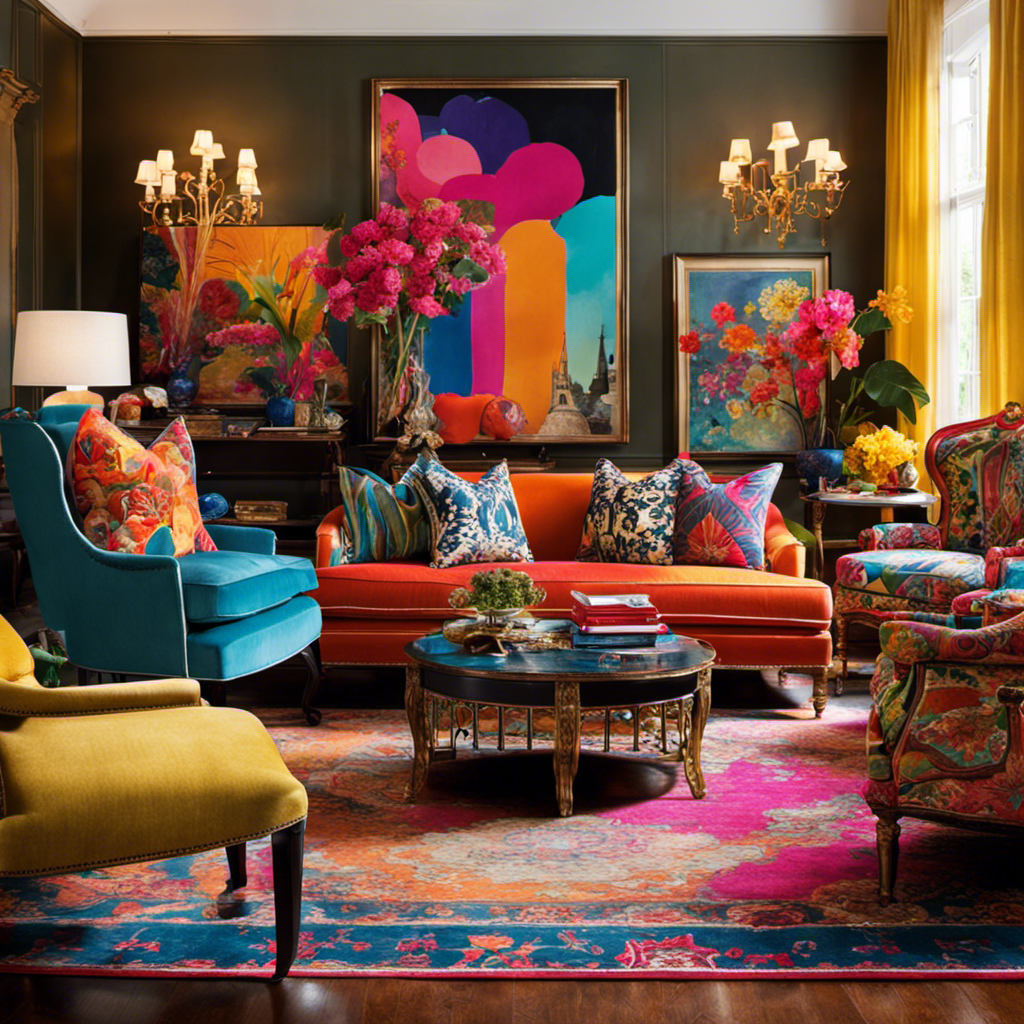
 Decor3 days ago
Decor3 days agoMaximalist Decor Explained: Embrace More Style
-

 Vetted3 weeks ago
Vetted3 weeks ago15 Best Drip Irrigation Systems to Keep Your Garden Thriving
-

 Vetted1 week ago
Vetted1 week ago15 Best Foot Massagers for Neuropathy to Soothe Your Feet and Relieve Discomfort
-

 Vetted2 weeks ago
Vetted2 weeks ago15 Best Sports Laundry Detergents for Keeping Your Activewear Fresh and Clean
-

 Vetted2 weeks ago
Vetted2 weeks ago15 Best Tall Toilets for Seniors That Combine Comfort and Safety
-

 Vetted3 weeks ago
Vetted3 weeks ago15 Best Dish Scrubbers to Keep Your Kitchen Sparkling Clean
-

 Decor3 weeks ago
Decor3 weeks agoWhat Is Eclectic Home Decor
-
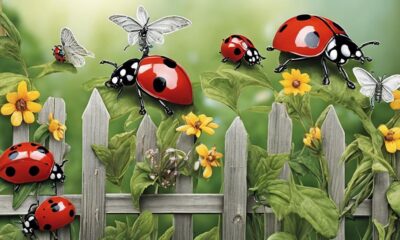
 Vetted4 hours ago
Vetted4 hours ago15 Best Organic Pest Control Solutions for a Naturally Pest-Free Home






